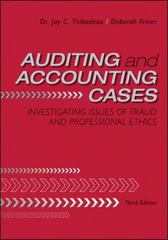A former BFA director incorporated both ALO and New Church Ventures. The entities had no employees of
Question:
A former BFA director incorporated both ALO and New Church Ventures. The entities had no employees of their own, and both organizations paid BFA substantial management fees to provide accounting, marketing, and administrative services. As a result, both ALO and New Church Ventures owed BFA significant amounts by the end of 1995. On an overall basis, BFA,
New Church Ventures, and ALO had a combined negative net worth of \($83.2\) million at year-end 1995, \($102.3\) million at year-end 1996, and \($124.0\) million at year-end 1997.2 From 1984 to 1997, BFA’s independent auditor, Arthur Andersen, issued unqualified audit opinions on BFA’s combined financial statements. However, it was later revealed that BFA had sold real estate to ALO and New Church Ventures and other related entities at its cost (or at a profit), even though the fair market value of the assets was significantly lower than the amounts recorded on BFA’s books.
Year-End Transactions In December of each year, BFA engaged in significant year-end transactions with its related parties, ALO and New Church Ventures. These related party transactions primarily included real estate sales, gifts, pledges, and charitable contributions. Without these year-end transactions, BFA, on a stand-alone basis, would have been forced to report a significant decrease in net assets in each year from 1991 to 1994. Yet BFA did not disclose any information about these material related party transactions in its financial statements for the years 1991 to 1994.3 As an example, the significant real estate transactions that occurred in December 1995 with Harold Friend, Dwain Hoover, and subsidiaries of ALO enabled BFA to report an increase in net assets of \($1.6\) million for the year ended December 31, 1995, as opposed to a decrease in net assets that would have been reported. Importantly, for BFA to recognize a gain on these transactions in accordance with GAAP, the down payment for the buyer’s initial investment could not be “funds that have been or will be loaned, refunded, or directly or indirectly provided to the buyer by the seller, or loans guaranteed or collateralized by the seller for the buyer.”4 However, in reality, the cash for the initial down payments on many of these real estate sales could be traced back to BFA via transactions with affiliates of ALO and New Church Ventures. Foundation Investments, Inc.’s Sale of Santa Fe Trails Ranch II, Inc., Stock Santa Fe Trails Ranch II, Inc., was a subsidiary of Select Trading Group, Inc., which was a subsidiary of ALO. The only significant asset owned by Santa Fe Trails Ranch II was 1,357 acres of undeveloped land in San Miguel County, New Mexico.
On December 26, 1995, 100 percent of the issued and outstanding common stock of Santa Fe Trails Ranch II was transferred from Select Trading Group to ALO. ALO then sold the stock to New Church Ventures in exchange for a \($1.6\) million reduction in ALO’s credit line that was already owed to New Church Ventures. On the same day, New Church Ventures sold the Santa Fe Trails Ranch II stock to Foundation Investments, Inc., a BFA subsidiary, in exchange for a \($1.6\) million reduction in the New Church Ventures’s credit line that was already owed to Foundation Investments. Also on the same day, Foundation Investments sold the Santa Fe Trails Ranch II stock to Harold Friend for \($3.2\) million, resulting in Foundation Investments recognizing a gain of \($1.6\) million in its financial statements..........
Case Questions
1. Consider the principles, assumptions, and constraints of Generally Accepted Accounting Principles (GAAP). Define the conservatism constraint and explain why it is important to users of financial statements.
2. Consider the significant year-end transactions consummated by BFA. Do you believe that the accounting for these transactions violated the conservatism constraint? Why or why not? Please be specific when answering the question.
3. Do you believe that BFA had established an effective system of internal control over financial reporting related to its significant year-end transactions? Why or why not?
4. Consider the sale of the Santa Fe Trails Ranch II stock by Foundation Investments to Friend. Do you believe that the auditor should have completed any additional testing beyond vouching the payment received from Friend? Provide the rationale for your decision.
5. Consider the role of president at BFA. Next, assume that as president, you are representing the upper management team at the Foundation’s annual meeting. During the question-and-answer session, an investor asks you to justify the creation of ALO and whether the real estate transactions between BFA and ALO were legitimate. Develop a response that could potentially satisfy the investor’s curiosity. Next, state the type of documentary evidence you would request if you were the investor.
Step by Step Answer:

Auditing And Accounting Cases Investigating Issues Of Fraud And Professional Ethics
ISBN: 9780078110818
3rd Edition
Authors: Jay Thibodeau, Deborah Freier





